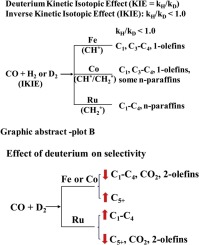Catalysis Today ( IF 5.3 ) Pub Date : 2019-01-28 , DOI: 10.1016/j.cattod.2019.01.059 Wenping Ma , Wilson D. Shafer , Michela Martinelli , Dennis E. Sparks , Burtron H. Davis

|
Deuterium tracer studies coupled with kinetic approach were developed to accurately determine the kinetic isotopic effects (KIE) for the CO hydrogenation and the formations of CO2, CH4 and light hydrocarbons (C2-C4) over iron, cobalt and ruthenium catalysts. Pronounced inverse kinetic isotope effects (IKIE) (kco,H/kco,D = 0.64–0.66) over the Fe and Co catalysts and a moderate IKIE (kco,H/kco,D = ∼0.8) on the Ru catalysts for the CO hydrogenation were obtained under typical FTS conditions. The IKIE was also found in CH4 formation, but the Co and Ru catalysts showed stronger IKIE than the Fe catalysts (kCH4/kCD4 = 0.6 vs 0.87). Regardless of catalyst type, only a minor normal KIE for the CO2 formation was obtained (kCO2, H/kCO2, D ˜ 1.1). The IKIE was found on various light 1-olefins and n-paraffin hydrocarbons as well. All the IKIEs can be explained by thermodynamic and kinetic isotope effects. The results suggested that deuterium was involved in quasi-equilibrated and hydrogenation steps that determined KIE. However, the Fe, Co and Ru catalysts showed different deuterium isotopic effect for the hydrocarbon selectivity. Deuterium promoted chain growth, thus lowered CH4 and light hydrocarbons selectivities and enhanced C5+ selectivity on both the Fe and Co catalysts; while it enhanced the hydrogenation rate to the low hydrocarbons and suppressed the formation of heavier hydrocarbons on the Ru catalysts.
Deuterium isotopic effect on the formation of 1-olefins, n-paraffins and 2-olefins in C10-C18 range (in liquid phase) was also studied in detail. Deuterium was found to enhance 1-olefins formation, but suppressed or only slightly changed n-paraffins formation over the Fe and Co catalysts. However, deuterium led to greater amount of n-paraffins and less 1-olefins on the Ru catalysts. The results suggested that the IKIE originated from different hybridization changes of carbon in C–H (sp1->sp2 and/or sp2->sp3) on the Fe, Co and Ru catalysts, which implied different reaction pathways on the Fe, Co and Ru catalysts.
中文翻译:

费-托合成:使用氘示踪剂结合动力学方法研究铁,钴和钌催化剂的动力学同位素效应
氘示踪剂研究与动力学方法相结合,以准确确定在铁,钴和钌催化剂上CO加氢以及形成CO 2,CH 4和轻烃(C 2 -C 4)的动力学同位素效应(KIE)。 Fe和Co催化剂具有明显的逆动力学同位素效应(IKIE)(k co,H / k co,D = 0.64-0.66),而Ru具有中等的IKIE(k co,H / k co,D =〜0.8)在典型的FTS条件下获得了用于CO加氢的催化剂。在第4通道中也发现了IKIE形成,但Co和Ru催化剂的IKIE比Fe催化剂强(k CH4 / k CD4 = 0.6 vs 0.87)。不论催化剂类型如何,仅获得用于CO 2形成的较小的正常KIE (k CO2,H / k CO2, D〜1.1 )。IKIE还存在于各种轻质1-烯烃和正链烷烃上。所有的IKIE都可以用热力学和动力学同位素效应来解释。结果表明,氘参与确定KIE的准平衡和氢化步骤。但是,Fe,Co和Ru催化剂对烃的选择性表现出不同的氘同位素效应。氘促进链增长,从而降低CH 4Fe和Co催化剂的轻烃选择性和增强的C 5+选择性;同时提高了低碳氢化合物的加氢速率,并抑制了Ru催化剂上较重碳氢化合物的形成。
还详细研究了氘同位素对C 10 -C 18范围(液相)中1-烯烃,正链烷烃和2-烯烃形成的影响。发现氘在Fe和Co催化剂上增强了1-烯烃的形成,但是抑制了或仅轻微改变了正链烷烃的形成。但是,氘导致Ru催化剂上的正链烷烃含量更高和1-烯烃含量更低。结果表明,IKIE源自Fe,Co和Ru催化剂上C–H中碳的不同杂化变化(sp 1- > sp 2和/或sp 2- > sp 3),这暗示了不同的反应途径。 Fe,Co和Ru催化剂。

























 京公网安备 11010802027423号
京公网安备 11010802027423号